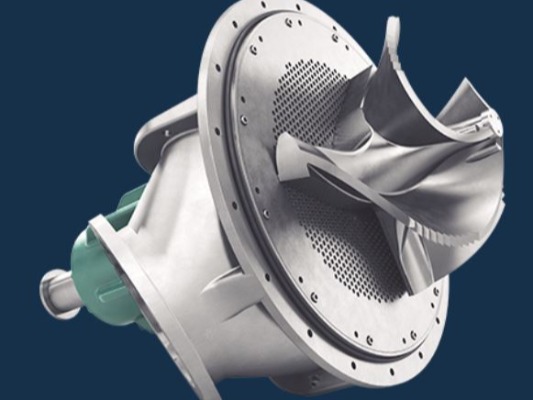Salvtech have been the exclusive UK agent for Cellwood Machinery since 2013. Salvetch are able to offer all of their high quality products to the U.K market for both the paper industry and anaerobic digestion industry. Slavtech has been in business for over 20 years, and is headed by a management team with many decades of experience in the paper industry, totally over 80 years of combined experience in this industry. This experience covers a number of different stages of the paper making process. In addition to this, our general manager, Martin, has had a number of years working in the energy from waste sector providing engineering and project management services. This expertise allows Slavtech to provide logical and practical solutions to your process needs, as well offering many different high quality products to its customers.
Grubbens, part of the Cellwood group, manufacture a range of specially designed pulpers to meet your process needs, whether you require a complete new system or a bespoke upgrade. Grubbens pulpers boast low energy consumption, low maintenance costs and high pulping consistency. This is on top of having the capability to disintegrate pulp gently, without the use of chemical additives or steam with wet-strength material.
Whether it’s a new pulper, or rebuilding an existing one, Cellwood’s high quality products and Salvtech’s know-how are the perfect partners for your process needs.
Pulper Rebuilds:
The benefits of a pulper rebuild are wide ranging and vary depending on the type of pulper and/or the customer requirements. Cellwood along with their incorporated brand, Grubbens, have had over 100 years’ experience within the pulp and paper industry. A good alternative to a new pulper is rebuilding an existing one. Cellwood – Grubbens’ extensive experience of rebuilds allows for cost effective solutions for both vertical and horizontal pulpers. Cellwood- Grubbens pulper rebuilds can offer long term cost savings through improving pulping consistency and increasing the capacity, in some cases pulper volume is also increased. This is mainly achieved by installing a more modern rotor unit within the pulper. The range of rotors offered by Cellwood - Grubbens are adapted for almost any pulp type. The unique design of the Grubben’s vats, is however, another feature which can bring significant benefits in a pulper rebuild. High operating consistency in combination with an optimal pulp movement also allows for higher capacity and improved pulping quality. As part of a pulper rebuild, we can also include a new mounting flange, a new front, and improved base design and deflectors. With all these different options and possibilities, the required process improvements are more than often achieved. The robust rotor units and improved pulper design can guarantee longevity, combined with low maintenance demands for the machine. The rotor unit is suitable for both belt and gear drives, which in turn opens up the possibility for flexible installation layouts. A pulper rebuild will reduce the energy demand, which allows savings in the range of 30–70%.
When rebuilding a vertical pulper the largest capacity increase is attained when changing the operating mode from ‘batch’ to continuous. In these cases, both pumps and piping are normally sufficient for the new capacity. The lowest energy consumption for batch mode is achieved at a consistency of around 6–8%, and for continuous mode at around 5–6%. Non wet strength paper grades normally lead to capacity increases after the rebuild. Pulpers are commonly rebuilt due to a change in furnish and paper grades. Typically, pulpers for wet strength paper grades with operating issues are often rebuilt, as they require a more efficient pulping.
Any brand or model of pulper can be rebuilt using Cellwood’s equipment and technology, including Voith*, Valmet*, Metso*, and even old Black Lawson* pulpers. UTM pulpers can also be rebuilt.
Case Studies:
1.Fine Paper Mill – UTM Pope pulper: Volume 36 m3.
The pulper was operating at 350 Tpd. After the rebuild to a type W36-105/84S, the capacity was increased to 720 Tpd. This lowered the energy consumption from 8,91 kWh/Ton to 6,67 kWh/Ton. A reduction of 25%.
2. Fine Paper Mill – UTM Pope pulper: Volume 36 m3.
The pulper was originally operating at 350 Tpd. After a second rebuild in 2008 to type W36-105/84S the capacity was 960 Tpd. The existing motor was kept in this instance. This lowered the original energy consumption from 8,91 kWh/Ton to 4,5 kWh/Ton. A reduction of 50%.
3. Liner Mill – UTM Pope Pulper : Volume 80 m3.
The pulper was commissioned in 1984 at a capacity of 616 Tpd. It was rebuilt in 1992 to type 2W80SR-82/84G with a capacity of 1186 Tpd. This was achieve without changing the motor or rpm. This lowered the energy consumption from 19,86 kWh/Ton to 10,32 kWh/Ton. A reduction of 48%. This rebuild changed the pulper from L to W, which meant there was a 20% increase in volume. It was rebuilt again in 1999 to type 2W80-105/84S at a new capacity of 1725 Tpd. This time the motor was changed but the energy consumption was lowered from 10,32 to 7,51 kWh/Ton. A decrease of 27%. Total energy reduction after the 2 rebuilds was 62%.
4. Newsprint Mill – TMP Pulper. Volume 23 m3.
The pulper was installed in the bleach plant. Originally it ran continuous at 4–5% consistency at a capacity of 800Tpd. The installed motor was 160kW. During the rebuild the capacity was increased to 1200 Tpd. The operating consistency was increased to 6–6,5% and the motor changed to a 200 kW version.


